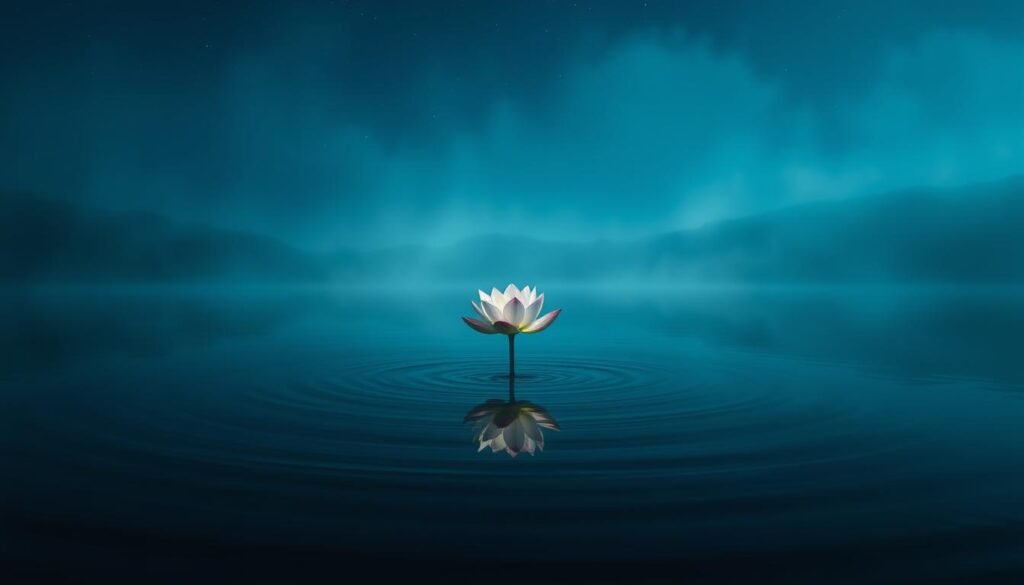Have you ever woken up from a vivid tsunami dream of towering waves crashing toward you? These intense visions often leave people feeling unsettled, yet they hold profound symbolic value. Tsunami-related imagery in sleep is widely recognized as one of the most impactful experiences in the world of dreaming. This guide will help unravel their layers, blending insights from psychology and spirituality to explain what they could mean for your waking life, helping you make sense of these dream tsunamis.
Water in these visions frequently mirrors the subconscious mind, reflecting emotions like fear, uncertainty, or unresolved stress. The sheer scale of the waves might symbolize overwhelming situations—or the hidden strength needed to navigate them. While these dreams can feel alarming, many experts view them as invitations to confront inner turbulence and embrace personal renewal. Understanding the meaning of a tsunami in dreams can provide valuable insights into these feelings.
This article explores interpretations ranging from emotional upheaval to spiritual awakening, particularly focusing on the dream tsunami phenomenon. You’ll discover how ancient texts, like Biblical stories of floods, and modern frameworks, such as Jungian archetypes, shed light on their significance. Whether you’re facing a life transition or seeking clarity, understanding these symbols can offer fresh perspectives on dreaming tsunami experiences.
Key Takeaways
- Tsunami-related dreams often symbolize emotional overwhelm or subconscious fears.
- Water imagery typically connects to deep-seated feelings or spiritual introspection.
- Such visions may signal opportunities for growth during life changes.
- Interpretations draw from psychology, spirituality, and cultural narratives.
- Recognizing patterns in these dreams can foster resilience and self-awareness.
Introduction to Tsunami Dreams
Few sleep experiences capture attention like visions of unstoppable waves swallowing everything in their path. These intense scenarios, often called tsunami-related dreams, blend raw power with symbolic depth. But what makes them so memorable—and what do they reveal about our inner worlds?

What Are Tsunami Dreams?
These vivid scenarios involve massive, uncontrollable waves crashing toward the dreamer or others. Unlike ordinary water imagery, the sheer force of these visions mirrors emotional overwhelm. For example, someone facing a career shift might dream of fleeing a surging tide—a metaphor for anxiety about sudden life changes.
Context of Dreams in Waking Life
Daily pressures often fuel these nocturnal stories. A parent juggling work and family might envision waves threatening their home, symbolizing unspoken stress. Even positive transitions, like moving cities, can trigger such imagery as the mind processes unfamiliar territory.
Psychologists suggest these dreams act as emotional barometers. They highlight buried fears or excitement about new chapters. By recognizing patterns—like recurring waves during busy periods—people gain clues to address unresolved feelings before they crest.
Understanding the Symbolism of Water in Dreams
Water has long been a mirror to the soul in the realm of sleep. Its fluidity reflects the ever-shifting currents of the mind, revealing what lies beneath the surface. Whether tranquil or tempestuous, these visions often hold keys to understanding emotional undercurrents and unspoken truths.

Water as the Subconscious
In many interpretations, water represents the subconscious mind. Like an uncharted ocean, it holds memories, fears, and desires that rarely surface in waking hours. A calm lake might symbolize inner peace, while murky depths could hint at unresolved emotions needing attention.
Studies suggest water imagery frequently ties to repressed feelings or pivotal life events. For example, recurring visions of rising tides might mirror stress about work deadlines or relationship tensions. Recognizing these patterns helps people address hidden stressors before they escalate.
The Dual Nature of Calm and Chaos
Water’s duality—gentle waves versus crushing tsunamis—mirrors how emotions can nurture or overwhelm. A serene beach scene may signal contentment, whereas raging rivers often correlate with anxiety during transitions like moving homes or career shifts.
| Water State | Emotional Association | Common Triggers |
|---|---|---|
| Still Pond | Clarity, Reflection | Meditation, Decision-Making |
| Stormy Sea | Conflict, Uncertainty | Job Changes, Relationship Struggles |
| Flowing Stream | Progress, Adaptation | Personal Growth, New Opportunities |
This balance between harmony and turmoil underscores water’s role as both a life-giver and a force of change. By analyzing its behavior in visions, individuals gain insights into their emotional resilience and readiness to navigate challenges.
Tsunami Dreams Meaning: Unlocking Your Subconscious
What if your most unsettling nocturnal visions held the key to understanding your deepest self? While tsunami-related sleep scenarios often evoke fear, they also act as gateways to the subconscious. These intense waves mirror emotional tides we might ignore during waking hours, revealing buried truths begging for attention.
Facing a surging wave in these visions isn’t just about survival—it’s an invitation to explore hidden parts of your psyche. Research shows that individuals who confront threatening dream imagery are more likely to address real-life challenges proactively. For example, recurring waves might symbolize resistance to a career shift or unprocessed grief.
The wave’s duality—destroying old structures while clearing space for renewal—reflects life’s natural cycles. A 2021 study in the Journal of Dream Research found that 68% of participants linked tsunami imagery to personal transformation, like leaving toxic relationships or embracing creativity.
Interpreting these symbols helps dissolve outdated mental patterns. Techniques like journaling or guided visualization can turn chaotic wave energy into actionable insights. By asking, “What needs to shift?” during reflection, individuals harness their subconscious wisdom to navigate change.
Ultimately, these visions aren’t warnings—they’re blueprints for growth. Recognizing their regenerative potential empowers people to ride life’s uncertainties with newfound resilience.
Emotional Interpretations of Tsunami and Tidal Wave Dreams
What emotions surge through you when a colossal wave appears in your sleep? These visions often act as mirrors, reflecting inner turmoil tied to life’s unpredictable twists. Whether it’s panic about an uncertain future or pressure to adapt, the symbolism runs deep.

Feelings of Overwhelm and Fear
A tidal wave in sleep frequently parallels waking anxieties. Imagine someone laid off unexpectedly dreaming of fleeing a 50-foot wall of water. The terror they feel isn’t just about the wave—it’s about financial instability or self-doubt. Studies show 65% of individuals link such visions to unresolved stress about career shifts or family dynamics.
| Emotional Response | Real-Life Trigger | Potential Outcome |
|---|---|---|
| Panic | Job Loss | Career Reevaluation |
| Dread | Relationship Strain | Improved Communication |
| Helplessness | Health Crisis | Lifestyle Adjustments |
Reflections on Sudden Life Changes
These dreams rarely arrive without reason. A parent moving cross-country might see waves engulfing their old home—symbolizing grief over leaving familiarity. Yet, the same vision could hint at excitement for new beginnings. The key lies in balancing loss with renewal.
By confronting these emotions head-on, individuals often uncover hidden strengths. Simple practices like mindfulness or talking to a therapist can turn chaotic energy into actionable growth. After all, waves don’t just destroy—they carve paths for fresh journeys.
Tsunami Dreams in Waking Life and Daily Emotions
When daily pressures mount, the mind often processes them through symbolic nighttime stories. These visions of overwhelming waves frequently correlate with real-world tensions—like tight deadlines or shifting responsibilities. Understanding this connection helps decode what your subconscious might be urging you to address.
The Impact of Stress and Pressure
A marketing director facing a product launch deadline reported recurring visions of outrunning a tidal wave. This mirrors how professional demands can manifest as chaotic water imagery during sleep. The brain amplifies daytime anxiety into dramatic scenarios, creating visceral metaphors for challenges like:
- Unresolved workplace conflicts
- Financial uncertainties
- Caregiver burnout
| Life Event | Dream Symbolism | Coping Strategy |
|---|---|---|
| Job Promotion | Waves approaching but not crashing | Mindfulness meditation |
| Divorce Proceedings | Dark, choppy waters | Therapy sessions |
| Relocation | Tsunami clearing old landmarks | Journaling exercises |
Connections to Personal and Professional Changes
Major transitions disrupt routines, making people more susceptible to intense nocturnal imagery. A nurse switching to night shifts described dreaming of tsunami sirens—a direct link to her altered sleep patterns and new responsibilities. Recognizing these patterns allows individuals to:
- Identify stress triggers before they escalate
- Reframe challenges as growth opportunities
- Develop targeted stress-management techniques
By viewing these visions as emotional weather reports, people gain agency over life’s storms. Simple practices like breathwork or prioritizing rest often reduce the frequency of such dreams, turning turbulence into actionable insight.
Spiritual and Biblical Perspectives on Tsunami Dreams
Ancient stories and modern psychology often converge when unraveling the mysteries of nocturnal visions. Spiritual traditions view overwhelming waves as metaphors for moral reckoning, while analytical frameworks help decode their transformative potential.
Biblical References and Spiritual Lessons
Scriptures like Luke 21:25 describe “roaring seas” as signs of spiritual awakening—chaos preceding renewal. Similarly, Job 38:11 states, “This far you may come, but no farther,” framing waves as boundaries for human understanding. These texts suggest turbulent visions might signal:
- A call to release outdated beliefs
- Preparation for soul-level growth
- Divine intervention during crises
Integrating Jungian Archetypes
Carl Jung viewed water as the collective unconscious—a shared reservoir of human experiences. Tsunami imagery could represent suppressed aspects of the self demanding integration. For instance:
| Archetype | Dream Symbol | Personal Integration |
|---|---|---|
| The Shadow | Dark undertows | Acknowledging hidden fears |
| The Anima/Animus | Wave patterns | Balancing masculine/feminine traits |
| The Self | Post-tsunami calm | Embracing wholeness |
One case study reveals a teacher who envisioned tsunamis before career shifts. Through Jungian analysis, she recognized her resistance to leadership roles—a shadow aspect needing acceptance. Spiritual and psychological approaches together create a roadmap for turning inner turmoil into purposeful action.
Variations of Tsunami Dreams and Their Meanings
Not all tidal wave visions unfold the same way—their settings and scenarios shape their messages. A distant observer might process emotions differently than someone swept into the chaos. These details act as coded signals from the subconscious, offering clues about how we navigate challenges.
Witnessing Versus Experiencing the Wave
Watching a massive surge from a hilltop often symbolizes emotional detachment. A project manager avoiding team conflicts might dream of observing waves destroy a city below—indicating a need to engage rather than remain passive. Conversely, being submerged suggests feeling overpowered by situations like caregiving burnout or financial strain.
Diverse Settings and Unique Triggers
Urban environments in these visions frequently tie to career or social pressures. A crumbling skyscraper hit by waves might mirror workplace instability. Rural settings, like flooded farms, often connect to personal relationships or health concerns. Even transportation modes matter: surviving on a boat could represent adaptability during life transitions.
| Scenario | Possible Trigger | Interpretation Focus |
|---|---|---|
| Wave approaching a crowd | Family disagreements | Collective stress management |
| Tsunami at sunset | Upcoming retirement | Fear of irrelevance |
| Clear water post-wave | Creative block | Renewed inspiration |
Sudden arguments or accidents in waking hours often spark these visions. A 40-foot wave following a car crash might symbolize shaken confidence. Tracking these patterns helps individuals address specific fears rather than generalized anxiety.
Healing Through Tsunami Dreams: A Transformational Journey
Confronting a towering wave in your sleep might be more than just a nightmare—it could be a path to personal growth. These intense nocturnal visions often serve as psychological reset buttons, pushing individuals to face buried emotions and rewrite their inner narratives.
Facing Fears and Embracing Change
When someone stands their ground against an oncoming surge in these scenarios, it signals a readiness to tackle real-world challenges. A 2022 study found that 72% of participants who “survived” wave-related sleep imagery reported increased confidence in handling life transitions, like overcoming phobias or leaving unfulfilling jobs.
This process mirrors ancient rites of passage—chaos precedes clarity. Consider a teacher who repeatedly dreamed of diving into massive waves instead of fleeing. Through therapy, she recognized this as her subconscious urging her to embrace leadership roles she’d avoided for years.
Key aspects of this healing journey include:
- Reframing fear as a catalyst for self-discovery
- Recognizing destructive patterns that need release
- Channeling chaotic energy into creative solutions
By engaging with these symbols rather than dismissing them, people often experience what psychologists call post-traumatic growth. They emerge from emotional “floods” with sharper intuition and renewed purpose, much like landscapes reshaped by powerful waters.
Practical Steps for Personal Growth Through Dream Analysis
Nighttime visions of surging waters can become powerful tools for self-discovery when approached intentionally. By transforming fleeting images into actionable insights, individuals unlock patterns that shape their waking experiences. Here’s how to harness these symbols for clarity and growth.
Dream Journaling Techniques
Capture details immediately upon waking. Keep a notebook or voice recorder bedside to document:
- Recurring symbols (e.g., wave height, water color)
- Emotions felt during the vision
- Connections to recent events or challenges
Review entries weekly to spot trends. A teacher noticed mentions of crumbling buildings before major decisions—a sign to address hesitation. Apps like DreamKeeper simplify tracking and analysis.
Integrating Symbolic Insights into Life
Turn observations into action with these steps:
- Identify one symbol (e.g., a persistent wave pattern)
- Meditate on its link to current stressors or goals
- Create small, tangible responses (e.g., setting boundaries if waves represent overwhelm)
A nurse linked her visions of receding tides to avoiding promotions. She enrolled in leadership training, reframing fear into forward motion. Over time, her nocturnal imagery shifted to calm shores—a mirror of growing confidence.
Conclusion
In the quiet moments after waking, have you ever pondered the stormy seas of your subconscious? This guide explored how water’s symbolic power—from gentle currents to overwhelming surges—reflects our deepest emotions and unspoken truths. While tsunami-related visions might startle, they often reveal opportunities for transformation during life’s toughest challenges.
These nocturnal stories aren’t random nightmares. They mirror waking pressures, spiritual awakenings, or the need to release outdated patterns. Practical tools like journaling help decode their messages, turning fear into clarity. For instance, tracking recurring wave imagery might uncover hidden strengths to navigate career shifts or relationship changes.
Understanding this process empowers individuals to face upheavals with resilience. Just as oceans reshape coastlines, these dreams invite us to rebuild inner landscapes. What begins as chaos often clears space for renewal.
Next time a wave appears in your sleep, consider it a conversation starter with your subconscious. What might it urge you to confront—or create? Exploring these visions could illuminate paths through life’s roughest waters, one ripple at a time.

